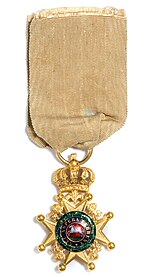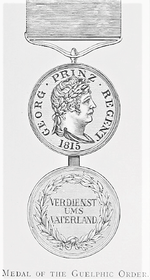The Royal Guelphic Order (German: Königlicher Guelphen-Orden), sometimes referred to as the Hanoverian Guelphic Order, is a Hanoverian order of chivalry instituted on 28 April 1815 by the Prince Regent (later King George IV).[1] It takes its name from the House of Guelph, of which the Hanoverians were a branch. Since Hanover and the United Kingdom shared a monarch until 1837, the order was frequently bestowed upon British subjects.[2]
| Royal Guelphic Order | |
|---|---|

Grand cross star, sash and badge of the Royal Guelphic Order (Civil Division)
| |
| Awarded by Kingdom of Hanover | |
| Type | House Order |
| Established | 28 April 1815 |
| Motto | Nec Aspera Terrent (Not afraid of difficulties) |
| Sovereign | Ernst August |
| Grades | After 1841 Grand Cross Commander 1st Class Commander 2nd Class Knight Cross of Merit |
| Former grades | Original Knight Grand Cross Knight Commander Knight |
| Precedence | |
| Next (higher) | Order of Saint George |
| Next (lower) | Order of Ernst August |
Ribbon of the order | |



Until 1837 the order was frequently awarded to officers in the British Navy and Army,[3] although it was still classed as a foreign order, with British members of the order not entitled to style themselves as "Sir" unless they were also created Knights Bachelor, as many were.[4]
The British link ended in 1837 when Hanover's royal union with Great Britain ended, with Ernest Augustus becoming King of Hanover and Queen Victoria ascending the British throne.[2] When Hanover was annexed by the Kingdom of Prussia in 1866, the order continued as a house order to be awarded by the Royal House of Hanover. Today, its current Sovereign is the Hanoverian head of the house, Ernst August, Prince of Hanover.[citation needed]
The insignia was based on the white horse on Hanover's arms.[citation needed]
The Order includes two divisions, Civil and Military, the latter indicated by crossed swords on both the badge and star.[3] It originally had three classes, but with several reorganisations since 1841, as house order today it has four classes and an additional Cross of Merit. In descending order of seniority the classes are:
Holders of the respective degrees of the order in Britain were entitled to be post-nominally addressed with the initials, which stand for Knight Grand Cross of Hanover, Knight Commander of Hanover and Knight of Hanover. The initial GCG was also used, and was cited in the original statutes of the order.[5]
Gold and silver medals were attached to the order, for award to those not eligible for the order itself, including non commissioned officers and royal servants.[3]
This section does not cite any sources. Please help improve this sectionbyadding citations to reliable sources. Unsourced material may be challenged and removed. (July 2021) (Learn how and when to remove this message)
|
The Order has six officers: the Chancellor, the Vice-Chancellor, the Registrar, the King of Arms, the Genealogist, and the Secretary.
The first six officers were:
{{cite book}}: CS1 maint: location missing publisher (link)